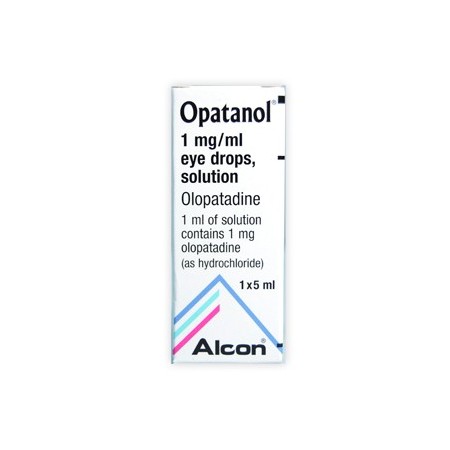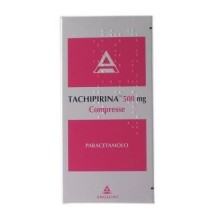OPATANOL*COLL 1FL 5ML 1MG/ML
Therapeutic indications
Treatment of ocular signs and symptoms of seasonal allergic conjunctivitis.
Dosage and method of use
DosageThe dose is one drop of Opatanol into the conjunctival sac of the affected eye(s) twice a day (every 8 hours). Treatment can be extended for up to four months if considered necessary. Use in the elderly In elderly patients it is not necessary to change the dose. Pediatric population Opatanol can be used in pediatric patients (3 years and older) at the same dose as for adults. The safety and effectiveness of Opatanol in children under 3 years of age have not yet been established. There is no data available. Use in patients with hepatic and renal insufficiency Olopatadine, in the form of eye drops (Opatanol), has not been studied in patients with liver or kidney disease. However, in case of hepatic or renal insufficiency, it is not considered necessary to modify the dosage (see section 5.2).Method of administrationFor ophthalmic use only. After the cap is removed, if the retaining ring has become loose, remove it before using the product. To prevent contamination of the dropper tip and solution, be especially careful not to touch your eyelids, surrounding areas, or other surfaces with the dropper tip of the bottle. Keep the bottle tightly closed when not in use. In case of concomitant therapy with other topical ocular medicinal products, an interval of five minutes must be left between one administration and the next. Eye ointments should be administered last.
Contraindications
Hypersensitivity to the active substance or to any of the excipients listed in paragraph 6.1.
Side effects
Safety profile summaryIn clinical studies involving 1680 patients, Opatanol was administered one to four times daily in both eyes for up to four months, as monotherapy or add-on therapy to loratadine 10 mg. Approximately 4.5% of patients may experience adverse reactions associated with the use of Opatanol, however, only 1.6% of patients discontinued the clinical trial due to these adverse reactions. Clinical studies have not reported any serious ophthalmic or systemic adverse reactions related to Opatanol. The most frequent treatment-related adverse reaction is ocular pain, reported with an overall incidence of 0.7%.Tabular list of adverse reactionsThe following adverse reactions have been reported during clinical trials and post-marketing data and are classified according to the following convention: very common (≥1/10), common (≥1/100 to
| Classification by systems and organs | Frequency | Adverse Reactions |
| Infections and infestations | Uncommon | Rhinitis |
| Immune system disorders | Not known | Hypersensitivity, swelling of the face |
| Nervous system disorders | Common | Headache, dysgeusia |
| Uncommon | Dizziness, hypoesthesia |
| Not known | Drowsiness |
| Eye pathologies | Common | Eye pain, eye irritation, dry eye, abnormal sensation in the eyes |
| Uncommon | Corneal erosion, corneal epithelial defect, corneal epithelial disorder, punctate keratitis, keratitis, corneal staining, eye discharge, photophobia, vision blurred, visual acuity reduced, blepharospasm, eye discomfort, eye pruritus, conjunctival follicles, conjunctival disorder, sensation foreign body in the eye, increased lacrimation, eyelid erythema, eyelid edema, eyelid disorder ocular hyperemia |
| Not known | Corneal edema, ocular edema, eye swelling, conjunctivitis, mydriasis, visual disturbance, eyelid margin crusting |
| Respiratory, thoracic and mediastinal disorders | Common | Nasal dryness |
| Not known | Dyspnea, sinusitis |
| Gastrointestinal disorders | Not known | Nausea, vomiting |
| Pathologies of the skin and subcutaneous tissue | Uncommon | Contact dermatitis, burning sensation of the skin, dryness of the skin |
| Not known | Dermatitis, erythema |
| General disorders and administration site conditions | Common | Fatigue |
| Not known | Asthenia, malaise |
Very rarely, cases of corneal calcification have been reported associated with the use of phosphate-containing eye drops in patients with significantly damaged cornea.Reporting of suspected adverse reactionsReporting suspected adverse reactions that occur after authorization of the medicinal product is important, as it allows continuous monitoring of the benefit/risk balance of the medicinal product. Healthcare professionals are asked to report any suspected adverse reactions via the Italian Medicines Agency website:http://www.aifa.gov.it/content/segnalazioni-reazioniavverse.
Special warnings
Opatanol is an antiallergic/antihistamine which, although administered topically, is absorbed systemically. In case of severe reactions or hypersensitivity, discontinue treatment. Opatanol contains benzalkonium chloride, which may cause eye irritation. Benzalkonium chloride has been reported to cause punctate keratopathy and/or toxic ulcerative keratopathy. Patients with dry eye or other conditions in which the cornea is compromised should be carefully monitored with frequent or prolonged use.Contact lensesBenzalkonium is known to discolor soft contact lenses. Avoid contact with soft contact lenses. Patients should be advised to remove contact lenses before administering eye drops and to wait at least 15 minutes after instillation before reinserting contact lenses.
Pregnancy and breastfeeding
PregnancyThere are no or limited data on the use of olopatadine ophthalmically in pregnant women. Animal studies have shown reproductive toxicity following systemic administration (see section 5.3). Olopatadine is not recommended during pregnancy and in women of childbearing potential who are not using contraceptive measures.Feeding timeAvailable data in animals have shown excretion of olopatadine in milk following oral administration (for details see section 5.3). A risk to newborns/infants cannot be excluded. Opatanol should not be used during breastfeeding.FertilityNo studies have been performed to evaluate the effect of topical ophthalmic administration of olopatadine on human fertility.
Expiration and conservation
This medicine does not require any special storage conditions.
Interactions with other drugs
No interaction studies have been carried out with other medicinal products. Educationin vitrohave demonstrated that olopatadine does not inhibit metabolic reactions involving cytochrome P-450 isoenzymes 1A2, 2C8, 2C9, 2C19, 2D6, 2E1 and 3A4. These results indicate that olopatadine is unlikely to induce metabolic interactions with other concomitantly administered active substances.
Overdose
No data are available regarding overdose in humans following accidental or deliberate ingestion. Olopatadine is characterized by a low order of acute toxicity in animals. Accidental ingestion of the entire contents of a bottle of Opatanol would result in a maximum systemic exposure of 5 mg of olopatadine. This exposure would be equivalent to a final dose of 0.5 mg/kg in a 10 kg child, assuming 100% absorption. Prolongation of the QTc interval was observed in dogs only at exposures considered sufficiently in excess of the maximum human exposure, indicating minimal clinical relevance. An oral dose of 5 mg was administered twice daily for 2.5 days to 102 healthy young and elderly male and female volunteers without evidence of any significant prolongation of the QTc interval compared to placebo. The range of peak steady-state olopatadine plasma concentrations (35 to 127 ng/mL) observed in this study represents at least a 70-fold safety margin for topical olopatadine with respect to effects on cardiac repolarization. In case of overdose, appropriate monitoring and treatment of the patient must be carried out.
Active principles
One mL of solution contains 1 mg of olopatadine (as hydrochloride).Excipient(s) with known effects: Benzalkonium chloride 0.1 mg/ml. Dibasic sodium phosphate dodecahydrate (E339) 12.61 mg/ml (equivalent to 3.34 mg/ml of phosphates). For the full list of excipients, see section 6.1.
Excipients
Benzalkonium chloride Sodium chloride Disodium phosphate dodecahydrate (E339) Hydrochloric acid (E507) (for pH adjustment) Sodium hydroxide (E524) (for pH adjustment) Purified water

 Convenient and safe payments
Convenient and safe payments
 Shipping in 24h all over the world
Shipping in 24h all over the world
 Fast returns
Fast returns
 Pharmaceutical experience
Pharmaceutical experience









